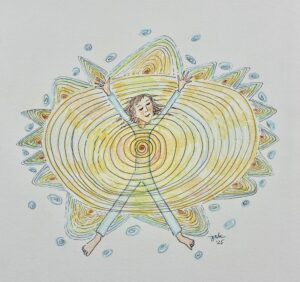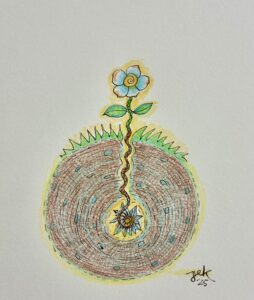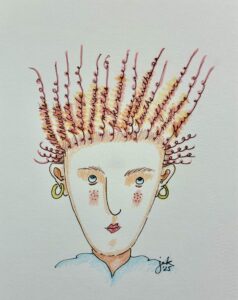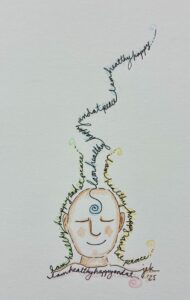
-Artwork © 2025 Jan Ketchel
As I have many times referenced, the Nagual, don Juan Matus, explained to his apprentice, Carlos Castaneda, that indeed, the world of solid objects that we live in, is real. However, he pointed out that a greater world of infinite, undifferentiated energy underlies this solid world, the world of all that is. Though challenging to reach, we all have access to the energy of the oneness of all that is, always.
Don Juan explained that our everyday world is but one potential interpretation of the energy of that infinitely vaster underlying world of energy. Our interpretation is our mental blueprint, formed by our belief, desire and demand, as envisioned in our imagination, and then assembled, by this intent, into solid physical reality.
We intend both the creation of our lives and the world we live in. What we believe, we are. However, what we are, is relative. Changing a belief can completely change who we are, though it does not ultimately free us from the karma of the experiences and actions of the characters we have been.
Nonetheless, even with scores to settle with the personality we have been, we can be freed to fully stalk a new life and come back later, with an enriched perspective, to complete that which must be completed from a former belief state.
Our beliefs fixate our energy into a solid world that is definitely real. However, it would be an error to say that it is the only reality. For instance, life in the finite world of the Earth suggests a world of definite limits. The notion of scant resource and how it should be distributed is a driving concern upon the Earth plane at present.
The rightness of prosperity in the midst of limited resource and overwhelming need is a legitimate concern. There is no error in this truth. However, if one opens to accessing the ocean of infinite energy that exists beyond one’s interpretation of everyday life, through the intent of autosuggestion, one can tap that infinite resource of all that is and receive a prosperous life, without depleting any resource upon the finite plane of Earth.
Thus, though scarcity is a truth, it is also an error from the point of view of infinite possibility, latently accessible through conscious intent presented to the subconscious mind. What we place our intent upon can generate a separate reality, such as a physical healing, actualized by a healing affirmation.
Phineas Parkhurst Quimby, the healer who healed Mary Baker Eddy, the founder of Christian Science, discovered that fixated beliefs can actually generate disease. When he worked with patients, he educated them as to how their thinking, though true from the premises issued from their interpretation of physical reality, also limited their access to a greater Truth; that at an energetic level anything is possible.
The error, or limitation in their thinking, generated the real outcome of disease but veiled their access to an alternative healing belief. If his patient was able to see the error, or limitation in their thinking, and open to the power of energetic Truth, they healed. Such is the potential power of suggestion to the subconscious mind.
Carl Jung grappled with the dilemma of error and truth by designating two centers in the personality, the ego and the Self. The ego is the center of the conscious personality that is informed largely by the five physical senses and the rational mind. The Self includes the ego but opens, through the subconscious portal, to the vastness of the collective unconscious and all that is. The Self also brings intuition and psychic powers to the personality, though the ego’s fixation on rationality can often dismiss its access to them.
Thus, the ego is real and part of the Self, but due to its limited skills and purview it is frequently in error in its assessments, which blocks its access to deeper Truth. Fortunately, as ego matures and becomes humbled by the greater knowledge and capacity of its Self, it raises its vibration and can develop a working relationship with the Self.
The Self operates at a finer energetic vibration than dense matter, and so the ego must learn to reach alpha and theta brainwave states to open the portal of direct communication with the Self.
Robert Monroe created the storage box metaphor, where one could deposit into the storage box one’s denser, thinking, beta brainwave mind, and thus be freed, with the assistance of higher brainwave entrainment, to explore deeper Truths and possibilities in infinity. Regardless of knowledge and fluidity gained in these journeys, one must ultimately re-associate with the contents of one’s storage box. In so doing, karma is neutralized and no longer a hindrance to radical change.
The point of the time we all spend in Earth School is for the ego to mature and gain support from the Self as it navigates the journey of resolving karma and the challenges it chose, at the level of Self, to fully explore in this lifetime.
The ego can begin a more definite relationship with the Self through its suggestions to the subconscious mind. One begins by shifting the energy state of the physical body through statements of relaxation, starting with the feet and progressing to the head, as the whole body is progressively relaxed, saying, for instance:
“My feet are relaxed, my calf muscles are relaxed, my thighs are relaxed, etc.”
Next, an autosuggestion is repeated several times to the subconscious mind. Here is an example of such an autosuggestion, but you can make up your own:
“I express deep gratitude to my subconscious mind for its unflinching support for the intentions I present to it. My subconscious mind is linked to Infinite Intelligence and Divine Love and has access to my High Self. I ask that my High Self guide me in ways I will recognize, with the ultimate goal being to achieve fulfillment and enlightenment in the lifetime I am in. I trust my subconscious mind to bring forth this connection.”
Relaxing one’s body to reach a higher vibration, then stating this affirmation several times a day, will reach the Truth of the Self. Breathe deeply as you relax and say your affirmation, releasing all fears and doubts. Be patient and know that your request will be answered. Instruct the ego to suspend the judgments that keep it locked exclusively in error.
The truth about error is that errors are truths, but lower case truths. Capitalized Truths are far more comprehensive and magical because they issue from the more expansive Truth of the Self.
To life ever increasingly beyond error,
Chuck




